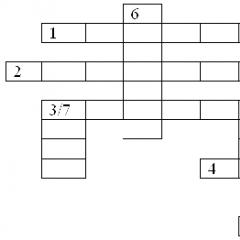Genetic relationship of inorganic substances. Genetic relationship between the main classes of inorganic substances Genetic relationship between chemical compounds
Genetic connection is a connection between substances that belong to different classes.
The main features of genetic series:
1. All substances of the same series must be formed by one chemical element.
2. Substances formed by the same element must belong to different classes of chemical substances.
3. The substances that form the genetic series of an element must be interconnected by mutual transformations.
Thus, genetic name a number of substances that represent different classes inorganic compounds, are compounds of the same chemical element, are connected by mutual transformations and reflect the common origin of these substances.
For metals, three rows of genetically related substances are distinguished, for non-metals - one row.
1. Genetic series of metals whose hydroxides are bases (alkalies):
metal→basic oxide→base (lye)→salt.
For example, the genetic series of calcium:
Ca → CaO → Ca(OH) 2 → CaCl 2
2. Genetic series of metals that form amphoteric hydroxides:
salt
metal→amphoteric oxide→(salt)→amphoteric hydroxide
For example: ZnCl 2
Zn → ZnO → ZnSO 4 → Zn(OH) 2
(H2ZnO2) ↓
Na 2 ZnO 2
Zinc oxide does not react with water, so salt is first obtained from it, and then zinc hydroxide. The same is done if the metal corresponds to an insoluble base.
3. Genetic series of non-metals (non-metals form only acid oxides):
non-metal→acid oxide→acid→salt
For example, the genetic series of phosphorus:
P → P 2 O 5 → H 3 PO 4 → K 3 PO 4
The transition from one substance to another is carried out using chemical reactions.
>> Chemistry: Genetic relationships between classes of substances
Genetic
is the connection between substances of different classes, based on their mutual transformations and reflecting the unity of their origin, that is, the genesis of substances.
First, we present our information about the classification of substances in the form of a diagram.
Knowing the classes of simple substances, it is possible to create two genetic series: genetic series of metals and non-metals.
The genetic series of metals reflects the relationship of substances of different classes, which is based on the same metal.
Distinguish two varieties of the genetic series of metals
1. Genetic series of metals to which alkali corresponds as a hydroxide. In general, such a series can be represented by the following chain of transformations:

2. Genetic series of metals that correspond to an insoluble base. This series is richer in genetic connections, as it more fully reflects the idea of mutual transformations (direct and reverse). In general, such a series can be represented by the following chain of transformations:

The genetic series of nonmetals reflects the relationship of substances of different classes, which is based on the same nonmetal.
Here, too, two varieties can be distinguished.
1. The genetic series of nonmetals, to which a soluble acid corresponds as a hydroxide, can be reflected in the form of the following chain of transformations:
non-metal -> acidic oxide -> acid -> salt
For example, the genetic series of phosphorus:
2. The genetic series of nonmetals, which correspond to an insoluble acid, can be represented using the following chain of transformations:
non-metal - acid oxide - salt - acid - acid oxide - non-metal
Since of the acids we have studied, only silicic acid is insoluble, as an example of the last genetic series, consider the genetic series of silicon:
1. Genetic connection.
2. Genetic series of metals and its varieties.
3. Genetic series of non-metals and its varieties.
Write down the reaction equations that can be used to carry out the transformations that underlie the given genetic series of metals and non-metals. Give the names of the substances and write the equations for reactions involving electrolytes in ionic form.
Write down the reaction equations with which you can carry out the following transformations (how many arrows, so many reaction equations):
a) Li - Li2O - LiOH - LiNO3
b) S - SO2 - H2SO3 - Na2SO3 - SO2 - CaSO3
Write the equations for reactions involving electrolytes in ionic form as well.
Which of the following substances will react with hydrochloric acid: magnesium, copper (II) oxide, copper (II) hydroxide, copper, magnesium nitrate, iron (III) hydroxide, silicon (IV) oxide, silver nitrate, iron (II) sulfide ? Write down the equations for possible reactions in molecular and ionic forms.
If reactions cannot be carried out, explain why.
Which of the following substances will react with sodium hydrochemide: carbon (IV) monoxide. calcium hydroxide, copper(II) oxide, copper(II) nitrate, ammonium chloride, silicic acid, potassium sulfate? Write down the equations for possible reactions in molecular and ionic forms. If the reactions do not occur, explain why.
Give definitions for all classes of substances given in the table. What groups is each class of substance divided into?
Date___________
Lesson No. 61 Topic : Genetic relationship between simple substances, oxides, bases, acids and salts. The presence and circulation of some inorganic substances in nature. Salt lakes in the Republic of Kazakhstan.
Target: Systematize, generalize and consolidate knowledge about the main classes of inorganic substances.
Tasks:
educational: consolidate the concepts of “genetic series”, “genetic connection”; teach how to compose genetic series of elements (metals and non-metals), compose reaction equations corresponding to the genetic series; check how well you have learned about chemical properties oxides, acids, salts, bases;
developing: develop the skills to analyze, compare, generalize and draw conclusions, draw up equations of chemical reactions;
educational: to promote the formation of a scientific worldview.
Lesson type: combined.
Work progress
1.Organizational and motivational stage.
Psychological mood for the lesson.
Everyone is in a cheerful working mood.
Joy and success await us in the lesson!
In every business we need patience and luck.
And then we will gain knowledge to boot!
2. Updating knowledge.
Guys, we have studied 4 classes of inorganic substances.
Name the classes.
And now we have interesting work ahead of us.
Division into groups.
By classes of substances: salts, oxides, acids and bases.
The first task is called “Pack a backpack”
Substance characterization plan:
1.Definition
2.Classification
3.Examples
A. Oxides are...
B. Acids are...
C. Foundations are...
D. Salts are...
Second task “Waterfall of substances”
Classify substances into classes
Al 2 O 3 , Mg(NO 3 ) 2 , H 2 SO 4 ,CO 2 , Ca(OH) 2 ,Na 2 O,H 2 CO 3 , Mg, K 2 O, NaCl, KNO 3 , H 2 SiO 3 , MgO, Na 2 SO 4 ,N 2 O 5 , NaOH, Ca, ZnCl 2 ,CaCO 3 ,Cl 2 O 7 , HCL, AL(OH) 3 , C, ZnSO 4 , AL 2 (SO4) 3 , H 2 SO 3 , Mg(OH) 2 , SiO 2
Third task« In the Cave of the Sorcerers»
Insert the formulas of the substances and the required coefficients in place of the gaps.
MgO + …….. = MgCl 2 + H 2 O
……..+ H 2 SO 4 = ZnSO 4 + H 2
NaOH + HCl = …….+ H 2 O
3.Learning new material.
Genetic connections are connections between different classes based on their mutual transformations.
Genetic series - a series of substances - representatives of different classes, which are compounds of one chemical element, connected by mutual transformations and reflecting the transformations of these substances. These series are based on the same element.
What types of genetic series are usually distinguished?
Among metals, two types of rows can be distinguished:
a) Genetic series in which alkali acts as a base. This series can be represented using the following transformations:
metal → basic oxide → alkali → salt
for example, the genetic series of potassium K → K 2 O → KOH→ KCl
b) Genetic series, where the base is an insoluble base, then the series can be represented by a chain of transformations:
metal → basic oxide → salt → insoluble base → basic oxide → metal
for example: Cu→ CuO → CuCl 2 → Cu(OH) 2 → CuO → Cu
Among non-metals, two types of series can also be distinguished:
a) Genetic series of nonmetals, where a soluble acid acts as a link in the series. The chain of transformations can be represented as follows: nonmetal → acidic oxide → soluble acid → salt.
For example: P → P 2 O 5 → H 3 PO 4 → Na 3 PO 4
b) Genetic series of nonmetals, where an insoluble acid acts as a link in the series: nonmetal → acidic oxide → salt → acid → acidic oxide → nonmetal
For example: Si→ SiO 2 → Na 2 SiO 3 → H 2 SiO 3 → SiO 2 → Si
Group work.
After studying additional material for the lesson, create a cluster of salt lakes of Kazakhstan. (10 min)
Exchange of information 6 min
D\z
Make a genetic series from these substances using all the formulas. Write the reaction equations that can be used to carry out this chain of transformations:
I option: ZnSO 4, Zn, ZnO, Zn, Zn(OH) 2
II option : Na 2 SO 4, NaOH, Na,Na 2 O
Lesson summary. Reflection.
This lesson is devoted to the generalization and systematization of knowledge on the topic “Classes of inorganic substances.” The teacher will tell you how you can get a substance of another class from substances of one class. The acquired knowledge and skills will be useful for drawing up reaction equations along chains of transformations.
During chemical reactions, a chemical element does not disappear; atoms are transferred from one substance to another. The atoms of a chemical element are, as it were, transferred from a simple substance to a more complex one, and vice versa. Thus, so-called genetic series arise, starting simple substance- metal or non-metal - and ending with salt.
Let me remind you that salts contain metals and acidic residues. So, the genetic series of a metal may look like this:
From a metal, as a result of the reaction of a compound with oxygen, a basic oxide can be obtained, a basic oxide, when interacting with water, gives a base (only if this base is an alkali), and a salt can be obtained from a base as a result of an exchange reaction with an acid, salt or acidic oxide.
Please note that this genetic series is only suitable for metals whose hydroxides are alkalis.
Let us write down the reaction equations corresponding to the transformations of lithium in its genetic series:
Li → Li 2 O → LiOH → Li 2 SO 4
As you know, metals, when interacting with oxygen, usually form oxides. When oxidized by atmospheric oxygen, lithium forms lithium oxide:
4Li + O 2 = 2Li 2 O
Lithium oxide, interacting with water, forms lithium hydroxide - a water-soluble base (alkali):
Li 2 O + H 2 O = 2LiOH
Lithium sulfate can be obtained from lithium in several ways, for example, as a result of a neutralization reaction with sulfuric acid:
2. Chemical information network ().
1. p. 130-131 No. 2.4 from Workbook in chemistry: 8th grade: to the textbook P.A. Orzhekovsky and others. “Chemistry. 8th grade” / O.V. Ushakova, P.I. Bespalov, P.A. Orzhekovsky; ed. prof. P.A. Orzhekovsky - M.: AST: Astrel: Profizdat, 2006.
2. p.204 No. 2, 4 from the textbook P.A. Orzhekovsky, L.M. Meshcheryakova, M.M. Shalashova “Chemistry: 8th grade,” 2013



